I have been trying to get to a few posts for several days now, intending to catch up a bit – you might have noticed that I’ve produced almost no philosophically turgid or religion-abusing posts recently. There’s also the two web pages I’ve been trying to finish, and some other odd projects. I just haven’t been finding the time. It’s very early morning Sunday right now, and I’d intended to do a post several hours ago on images I’d taken Saturday, but my lower gastro-intestinal tract had other suggestions which couldn’t really be ignored. So here’s one post, with perhaps another to follow later on today. That’s if I can cut down the number of typos I’ve produced so far…
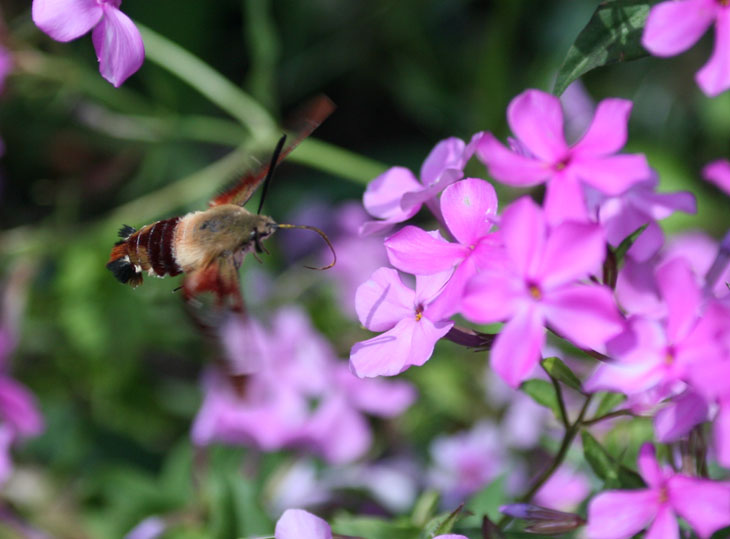
I arrived early at the botanical garden to meet with a student, and poked around a bit. Above and below, a hummingbird clearwing moth (Hemaris thysbe) visited some flowers while I was standing nearby, and I chased a few images since it was convenient. The various Hemaris moths are hyperactive and can be hard to nail focus on, but above I at least caught it while it was extending its proboscis. I’m not sure if the image below truly counts as hovering, even though the moths don’t actually land on the flowers they drink from; this one appears to be braced, at least, and those wings might look stationary but they’re not – 1/2000 second shutter speed at f4 can do that.
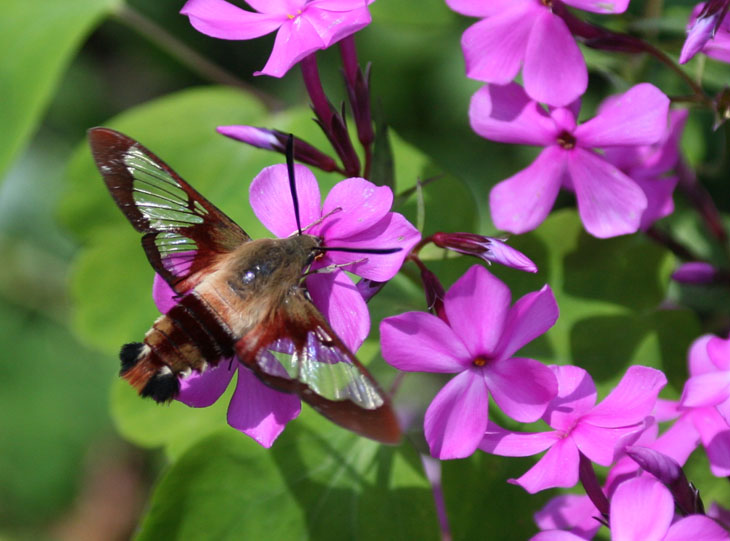
[By the way, I did get to the month-end blog maintenance duties, and note that I set a new record for image uploads in April, 65 in total. That’s actually pretty good for a slow month, and not one of them was from anyone else – the previous two record-holders that tied at 62 both featured several images that were not my own. So, yeah. I also noted that on the last day of both March and April I posted surreal shots, so now I’m feeling obligated to do this every month. Don’t know if that’s gonna happen or not.]
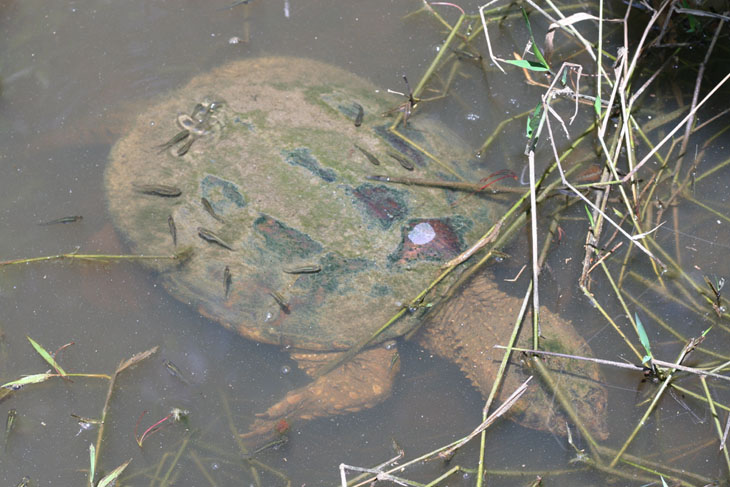
Above, a common snapping turtle (Chelydra serpentina) basks in the sunlight, with numerous minnows (Fishus insignificus – actually I have no idea what they are) taking advantage of the warmer water produced by sunlight reflecting/radiating off of its shell. I suspect they give a pretty good idea of the size, but if not, I’ll say that its shell length was about 30 cm. Snappers do get big.
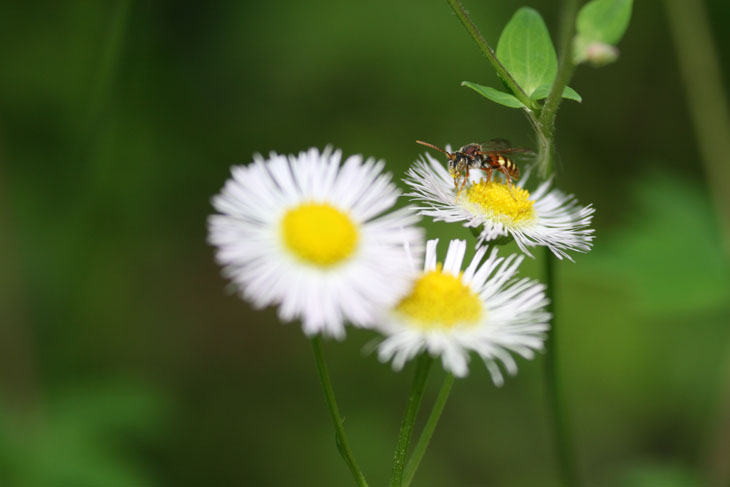
This one is just to show what the entire frame that I captured looks like, as an unidentified small wasp visited these flowers. The next one is the detail crop from the same image.
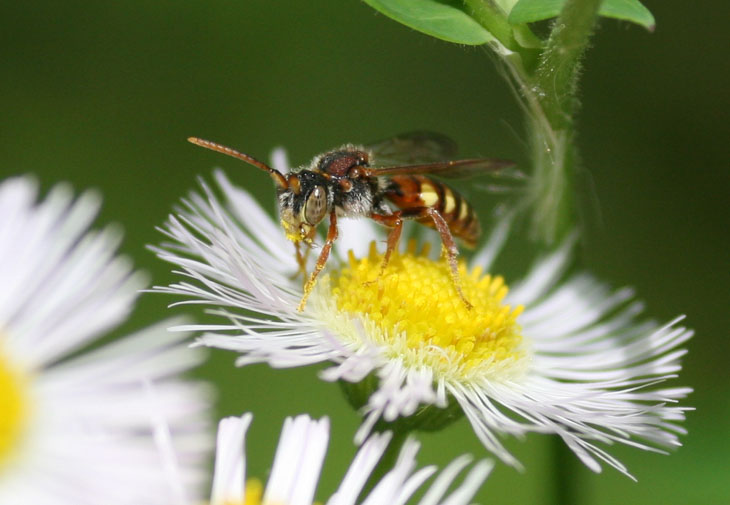
The conscientious side of me says that I should have uploaded the image to BugGuide.net to get a positive identification, but I don’t feel like waiting right now and I already skimmed the site trying to pin it down. So you just have to enjoy looking at the image in ignorance (unless, naturally, you’re more educated than I am, in which case you can roll your eyes or scoff or smirk condescendingly – whatever works.) As might be obvious, it’s quite small.
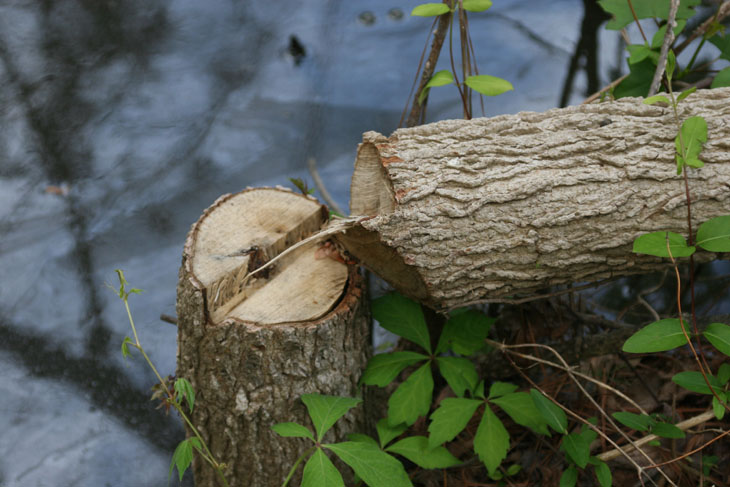
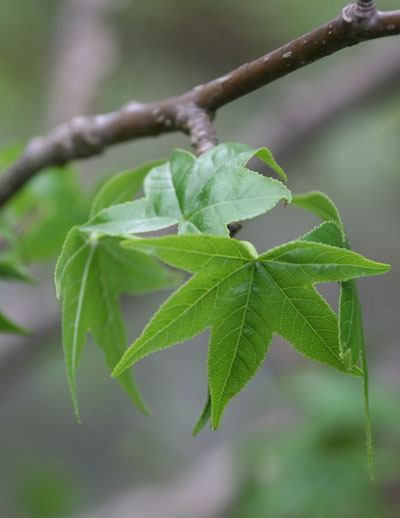 On my return from meeting with the student, I took a quick walk around the nearby pond, and I’ve been looking at this for weeks now and had to comment. Back during the bad winter storm that we had, a massive tree near the pond came down, bringing electrical wires with it, and a smaller tree had to be cut away because it was entangled in the wires. The trunk was left there, but somehow it has sprouted new leaves with the warmer weather. In a couple of weeks they haven’t really progressed beyond the point seen here, five cm across or less, but they also haven’t died. I’m guessing this is just the residual moisture/sap leaching out of the trunk and eventually, without further nutrients, these will die off, but it seems weird – the tree was dropped, like, nine weeks ago. I’ve seen uprooted trees that simply started growing while horizontal, and cut trees sprout new branches from the stump all the time, but never a tree completely severed from its root system still kicking. This may be how the zombie apocalypse starts – I’m guessing this one won’t really make for exciting television.
On my return from meeting with the student, I took a quick walk around the nearby pond, and I’ve been looking at this for weeks now and had to comment. Back during the bad winter storm that we had, a massive tree near the pond came down, bringing electrical wires with it, and a smaller tree had to be cut away because it was entangled in the wires. The trunk was left there, but somehow it has sprouted new leaves with the warmer weather. In a couple of weeks they haven’t really progressed beyond the point seen here, five cm across or less, but they also haven’t died. I’m guessing this is just the residual moisture/sap leaching out of the trunk and eventually, without further nutrients, these will die off, but it seems weird – the tree was dropped, like, nine weeks ago. I’ve seen uprooted trees that simply started growing while horizontal, and cut trees sprout new branches from the stump all the time, but never a tree completely severed from its root system still kicking. This may be how the zombie apocalypse starts – I’m guessing this one won’t really make for exciting television.
 I’ve been seeing water snakes at various places around this pond for weeks, but have never gotten a decent image of any until now. And this one was only because, with those eyes, it couldn’t make me out very well and I was careful not to alert it in other ways. Snakes don’t exactly have ears (according to new research, they have the ability to hear, but only through the vibrations of their skeletal system it seems,) but they’ll still pick up on incautious movements nearby, so I stepped very gently. This snake is not old or anything, simply about to shed any time now – if I go out today when it’s light I’ll probably be able to find the skin, since it’s been many hours after getting this image. The skin gets cloudy and dark right before a shed, including the eyes, and it means they can only see blobs. When you spot a snake with blue eyes, leave it be, since it will be very defensive in its vulnerable state, and you will likely get bitten. Northern water snakes (Nerodia sipedon) are notoriously defensive anyway, likely to bite with any handling, and much more so in this condition. I managed to get quite close, though probably not close enough to be bitten, but as I finished my photo session I rose too quickly; the snake was able to make out that movement, and shot into the water instantly.
I’ve been seeing water snakes at various places around this pond for weeks, but have never gotten a decent image of any until now. And this one was only because, with those eyes, it couldn’t make me out very well and I was careful not to alert it in other ways. Snakes don’t exactly have ears (according to new research, they have the ability to hear, but only through the vibrations of their skeletal system it seems,) but they’ll still pick up on incautious movements nearby, so I stepped very gently. This snake is not old or anything, simply about to shed any time now – if I go out today when it’s light I’ll probably be able to find the skin, since it’s been many hours after getting this image. The skin gets cloudy and dark right before a shed, including the eyes, and it means they can only see blobs. When you spot a snake with blue eyes, leave it be, since it will be very defensive in its vulnerable state, and you will likely get bitten. Northern water snakes (Nerodia sipedon) are notoriously defensive anyway, likely to bite with any handling, and much more so in this condition. I managed to get quite close, though probably not close enough to be bitten, but as I finished my photo session I rose too quickly; the snake was able to make out that movement, and shot into the water instantly.
By the way, the undergrowth to the right of the frame prevented me from getting any shots from that side, which meant I didn’t have a decent view of what appears to be some injuries to its head on that side, vaguely visible in the image here. It’s not surprising – water snakes often bask during the day because the water can sap their body heat, but this makes them vulnerable to more predators than the snakes which are primarily nocturnal. Obviously it survived – see above about the defensiveness.
And I close with an image taken right outside our front door, an orchard orbweaver (Leucauge Venusta) opportunistically perched on the phlox. I’m pleased that so much of the orb web came out this visibly – I really didn’t think that it would. And yes, I did position myself so that the spider was placed against the bright leaf, for contrast.





















































Fishus insignificus? Really? Too funny! Though those minnows might not agree.